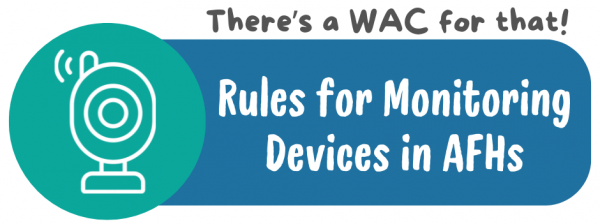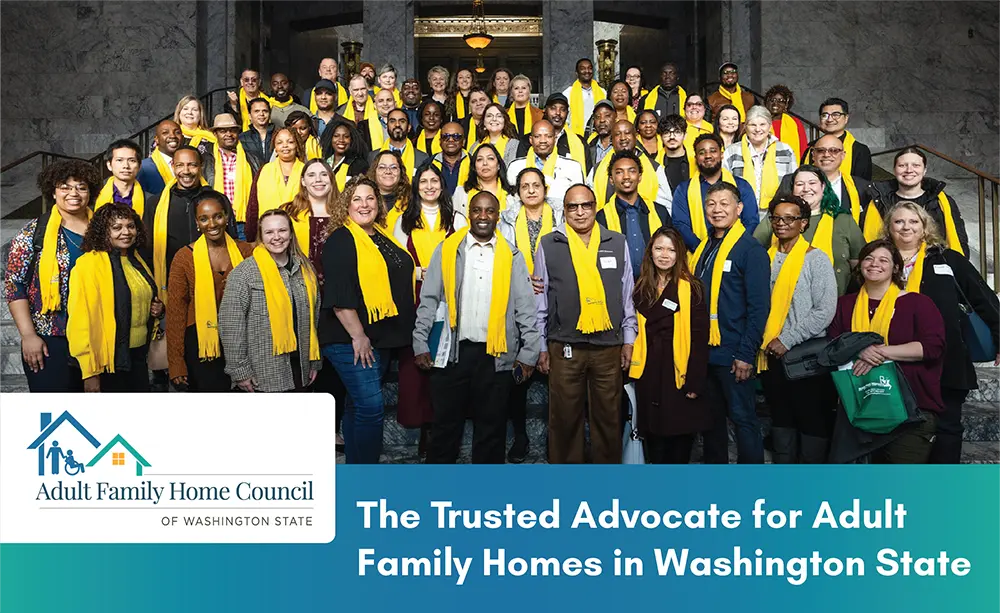
There's a WAC for That!
Rules for Video and Audio Monitoring in AFHs
In the realm of adult family homes, ensuring the safety and privacy of residents is paramount. Washington Administrative Code (WAC) 388-76-10720 and WAC 388-76-10725 provide clear guidelines on the use of electronic monitoring equipment, including video and audio devices, within these homes. Here’s what providers need to know about when and where they can use cameras.
General Restrictions
Under WAC 388-76-10720, adult family homes are generally prohibited from using audio monitoring equipment or video monitoring equipment that includes an audio component. However, there are specific exceptions where video monitoring without audio is permitted:
- Entrances and Exits: Cameras can be focused solely on doorways, ensuring they do not capture areas where residents gather.
- Outdoor Areas: Monitoring is allowed in outdoor spaces accessible to both residents and the public, such as driveways or walkways, to prevent theft, property damage, or other crimes.
- Outdoor Areas Not Commonly Used by Residents: These areas can be monitored without restrictions.
- Designated Smoking Areas: If residents need supervision for smoking, video monitoring is permitted under strict conditions, including visible cameras and staff supervision.
Notification and Consent
Homes must notify all residents in writing about the presence of video monitoring equipment. This notification must include details about who has access to the monitoring and must be acknowledged in writing by both the resident and the home.
Resident-Requested Monitoring
WAC 388-76-10725 outlines the rules for resident-requested electronic monitoring:
- Consent: Audio or video monitoring in a resident’s sleeping area requires the resident’s or their representative’s consent.
- Safety: Equipment must be installed safely.
- Admission and Discharge: Homes cannot refuse admission or discharge residents solely based on monitoring requests.
- Limitations: Residents can limit monitoring to specific times or situations.
- Recording Release: Recordings can only be released to authorized persons or as required by law.
- Quarterly Reevaluation: The use of monitoring must be reevaluated with the resident at least quarterly.
Stopping Monitoring
Monitoring must cease immediately if the resident withdraws consent, the roommate objects, or the resident becomes unable to give consent.
Special Considerations
For video monitoring without audio, consent can be given by the resident’s representative. For audio monitoring, consent must come from the resident or their court-appointed guardian with specific authorization.
Unauthorized Monitoring
If unauthorized monitoring is discovered, the home must disconnect or remove the equipment until proper consent is obtained.
By adhering to these WAC guidelines, adult family homes can ensure they respect residents’ privacy while maintaining a safe environment. Providers should stay informed and compliant to foster trust and security within their homes.
Resources
Related WACs
WAC 388-76-10720
Electronic monitoring equipment—Audio monitoring and video monitoring.
(1) Except as provided in this section or in WAC 388-76-10725, the adult family home must not use the following in the home or on the premises:
(a) Audio monitoring equipment; or
(b) Video monitoring equipment if it includes an audio component.
(2) The home may video monitor and video record activities in the home, without an audio component, only in the following areas:
(a) Entrances and exits if the cameras are:
(i) Focused only on the entrance or exit doorways; and
(ii) Not focused on areas where residents gather;
(b) Outdoor areas accessible to both residents and the public, such as, but not limited to, driveways or walkways, provided that the purpose of such monitoring is to prevent theft, property damage, or other crime on the premises;
(c) Outdoor areas not commonly used by residents; and
(d) Designated smoking areas, subject to the following conditions:
(i) Residents are assessed as needing supervision for smoking;
(ii) A staff person watches the video monitor at any time the area is used by such residents;
(iii) The video camera must be clearly visible;
(iv) The video monitor must not be viewable by the general public; and
(3) The home must notify all residents in writing of the video monitoring equipment. The home must:
(a) Identify in the written notification each person or organization with access to electronic monitoring; and
(b) Retain an acknowledgment that has been signed and dated by both the resident and the home that states in writing that the resident has received this notification.
(4) The presence of cameras must not alter the obligation of the home to provide appropriate in-person assistance and monitoring due to individual physical or cognitive limitations.
WAC 388-76-10725
Electronic monitoring equipment—Resident requested use.
(1) Audio or video monitoring equipment may not be installed in an adult family home to monitor any resident sleeping area unless the resident or the resident’s representative has requested and consents to the monitoring;
(2) Electronic monitoring equipment must be installed in a manner that is safe for residents;
(3) An adult family home must not refuse to admit an individual, or discharge a resident, solely because of a request to conduct authorized electronic monitoring;
(4) A resident may limit consent for use of electronic monitoring devices in their bedrooms to specific times or situations, pointing the camera in a particular direction, or prohibiting the use of certain devices;
(5) The release of audio or video monitoring recordings by the facility is prohibited, except to authorized persons or as otherwise required by law;
(6) If the resident requests that the home conduct audio or video monitoring of their sleeping area, before any electronic monitoring occurs the home must ensure:
(a) That the electronic monitoring does not violate chapter 9.73 RCW;
(b) The resident’s roommate has provided written consent to electronic monitoring, if the resident has a roommate; and
(c) The resident and the home have agreed upon a specific duration for the electronic monitoring and the agreement is documented in writing.
(7) The home must:
(a) Reevaluate the use of the electronic monitoring with the resident at least quarterly; and
(b) Have each reevaluation in writing signed and dated by the resident.
(8) The home must immediately stop electronic monitoring if the:
(a) Resident no longer wants electronic monitoring;
(b) Roommate objects or withdraws the consent to the electronic monitoring; or
(c) Resident becomes unable to give consent, unless consent has been provided by a resident’s representative as described in this section.
(9) For the purposes of consenting to video electronic monitoring, without an audio component, the term “resident” includes the resident’s representative.
(10) For the purposes of consenting to audio electronic monitoring, the term “resident” includes only:
(a) The resident residing in the home; or
(b) The resident’s court-appointed guardian or attorney-in-fact who has obtained a court order specifically authorizing the court-appointed guardian or attorney-in-fact to consent to audio electronic monitoring of the resident.
(11) If the resident’s decision maker consents to audio electronic monitoring as specified in subsection (10) of this section, the home must maintain a copy of the court order authorizing such consent in the resident’s record.
(12) If the adult family home determines that a resident, resident’s family, or other third party is electronically monitoring a resident’s bedroom without complying with the requirements of this section, the home must disconnect or remove such equipment until the appropriate consent is obtained and notice given as required by this section.
(13) Nothing in this section prohibits or limits an adult family home from implementing electronic monitoring pursuant to a resident’s negotiated care plan, including but not limited to motion sensor alerts, floor pressure sensors, or global positioning devices, where the monitoring does not entail the transmittal or recording of a human-viewable image, sound, or resident name.
Not a Member Yet?
Membership fees enable the Council to cover legal expenses and fund staff to advocate with the state and regulatory agencies. The participation of every adult family home is vital to ensuring fair regulations and rates that accurately reflect the costs of caring for our vulnerable adults. Consider becoming a member of the Council to help us continue improving conditions for all adult family homes in Washington State.

